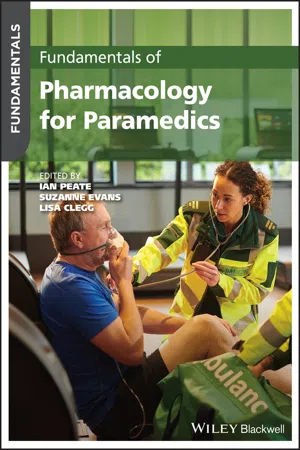
Fundamentals of Pharmacology for Paramedics
Ian Peate, Suzanne Evans, Lisa Clegg, Ian Peate, Suzanne Evans, Lisa Clegg
- English
- ePUB (apto para móviles)
- Disponible en iOS y Android
Fundamentals of Pharmacology for Paramedics
Ian Peate, Suzanne Evans, Lisa Clegg, Ian Peate, Suzanne Evans, Lisa Clegg
Información del libro
Fundamentals of Pharmacology for Paramedics provides students with the insight and understanding of pharmacological essentials needed to respond effectively to the patients' needs. This textbook will help students improve, expand, and enhance their expertise and the overall health and wellbeing of their patients, while boosting their self-confidence as paramedics in the process. This textbook integrates the extensive knowledge of pharmacology into a workable and accessible plan of care that will help to improve patient care. The book also includes:
- Thorough introductions to pharmacology and how to use pharmaceutical, and prescribing reference guides
- Comprehensive explorations of the legal and ethical issues of pharmacology within paramedicine and the role of the paramedic in medicines management
- Practical discussions of pharmacodynamics, pharmacokinetics, drug formulations, and adverse drug reactions
- In-depth examinations of a wide variety of medicines, including analgesics, antibacterials, and medications used in the cardiovascular, renal, respiratory, gastrointestinal, and nervous systems
Written for students of paramedicine, Fundamentals of Pharmacology for Paramedics would also prove an indispensable resource for practicing paramedics seeking a practical, one-stop reference on a challenging subject.
Preguntas frecuentes
Información
Chapter 1
Introduction to pharmacology
Aim
Learning outcomes
- Be aware of the potential for error in every stage of drug administration, and strategies to avoid medication error.
- Be able to distinguish the generic and trade names of drugs, and know the conventions for generic names of drugs in the same class.
- Know the range of sites at which the majority of drugs act to produce their effects.
- Understand the importance of correct choice, dosing and administration of a drug.
Test your knowledge
- Which medicines are considered to be completely safe?
- How can the risk of accidental harm from medicines be reduced?
- When taking a medication history, what should you prompt a patient to include?
- What is the generic name and what is the trade name of a medication and where is each name located on the packaging?
- The clinical assessment and management of patients, including taking a complete medical and medication history.
- Therapeutic product use, including misreading of labelling or mistaking products with similar packaging.
- Intravenous dosing and administration, including calculating dose and setting up pumps.
- Handover communications, including communication to hospital personnel.
- Inventory management, including correct restocking of the ambulance with medication and correct positioning of drugs.
SAMPLE
- Signs
- Allergies
- Medication
- Past pertinent history
- Last oral intake
- Events leading to injury